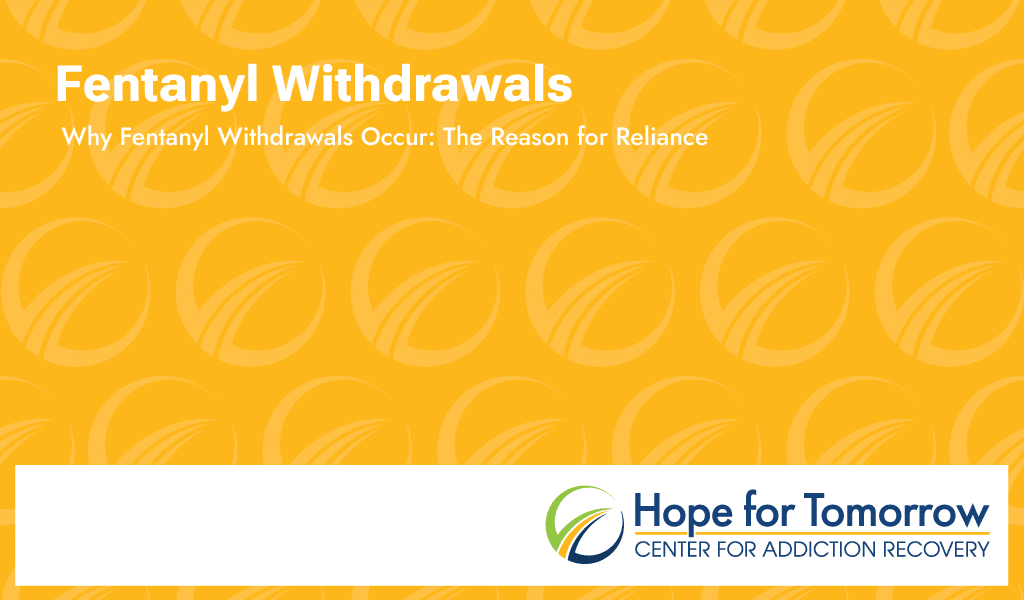

Anyone can relate to the aches and pains of the flu. All of the symptoms that accompany it are annoying at best, and dangerous at worst. Now, imagine those flu symptoms, plus an overwhelming craving for fentanyl. Maybe you don’t have to imagine, because it’s your life, or because you watch your loved one experience fentanyl withdrawals regularly. They’re painful, and they’re a huge part of the reason why fentanyl use is so hard to stop.
Three of every four overdose deaths in West Virginia are caused in part, by fentanyl. It’s evident that fentanyl use is a growing problem, and it’s a good thing to want to stop using it. That doesn’t mean it’s easy. Fentanyl is strong, and fentanyl withdrawal can be, too. That’s why detox programs like what Hope for Tomorrow offers are so helpful.
We know seeking treatment can be intimidating, and that you may just be looking for answers and ways to survive fentanyl withdrawal. We’ll always encourage treatment, but we can provide all you need to know about fentanyl withdrawals, too.
Fentanyl withdrawal occurs once the body becomes so used to fentanyl in its system that it becomes dependent on it. Your body and brain don’t know how to function normally without it. You can experience fentanyl withdrawal with as little as a week of taking fentanyl. That’s part of why it’s so important not to take any opioids long-term, whether they’re prescribed or taken illicitly.
People often say fentanyl withdrawal feels like a bad flu. Many of the symptoms overlap, such as:
The good news is, for as painful as withdrawal symptoms can be, they’re rarely life-threatening. The biggest physical risk comes from dehydration due to diarrhea and vomiting.
In addition to physical symptoms, fentanyl withdrawal often comes with the following mental symptoms:
Suicidality is also possible during the withdrawal process. This can come from the depression withdrawal can bring on, a desire to end the pain of withdrawal, or hopelessness in those fighting withdrawal who want to stop using fentanyl. No matter the reason, it’s vital to contact a medical professional immediately if you experience any thoughts of suicide.

Just like everyone with fentanyl use disorder is different, so is everyone’s fentanyl withdrawal timeline. Unfortunately, there isn’t a standard formula to guide people through the process, but there are some commonalities in the overall withdrawal timeline..
There are no official stages of fentanyl withdrawal, but symptoms generally can start as early as eight hours after the last dose. The first 24 hours of symptoms tend to be mild. The flu-like symptoms typically come within a couple of days, and peak around three days in. Most of the time, after a week, the fentanyl will be out of your system and the withdrawal symptoms will ease up. Sometimes, though, the symptoms will last longer, even up to weeks after the last dose.
This is part of the reason why it’s so hard to stop using fentanyl: Withdrawal symptoms are painful, and taking more fentanyl puts a stop to them. The problem is, the more fentanyl someone takes, the worse the withdrawal symptoms will be when fentanyl isn’t in their system.
How long withdrawal symptoms last and how severe they are depends on multiple factors. How long someone has taken fentanyl, how much fentanyl they use, and how often they use it all influence this timeline. Whether they take any additional substances, including legal prescriptions, alongside fentanyl can also impact the withdrawal process.
As with most things, the person’s body type and general health outside of substance use also impacts withdrawal times and severity.
Withdrawal symptoms can be incredibly painful and unpleasant. This can lead people to do whatever they can to make them stop, which often includes returning to fentanyl use. Returning after a period of abstinence is even more dangerous than any other instance of fentanyl use, because your body may have a lower tolerance than it did before you quit. You may administer the same dose of fentanyl you did before trying to stop, and overdose.
Fentanyl is the strongest opioid available. It is 100 times stronger than morphine, and even two milligrams – less than a tenth of the size of a penny – can cause an fentanyl overdose due to its potency. This makes fentanyl withdrawal more dangerous by extension, both due to a higher severity of withdrawal symptoms and a higher chance of overdosing.
The best way to avoid fentanyl withdrawal is by weaning off of it under a doctor’s watchful eye. Quitting “cold turkey” means stopping fentanyl use abruptly, and while wanting to quit using fentanyl is a good idea, that can make withdrawal symptoms intense.
If you’re taking fentanyl per your doctor’s recommendation, work with them to wean – also known as taper – off of the medication. They will build a plan for you based on what’s best for your health and making withdrawal symptoms as manageable as possible. Just like the withdrawal timeline, the tapering timeline varies based on how much fentanyl you’ve taken, and for how long. The more fentanyl you’ve used, the longer it will take to taper off of it safely. It’s important to stay in touch with your doctor and follow their directions closely. If you’re tempted to take more fentanyl than your doctor instructed to cope with withdrawal, contact your doctor right away.
If you have a fentanyl use disorder, you may feel inclined to stop your fentanyl use alone. While some people can do it, it’s difficult to manage withdrawal by yourself, and you may go back to fentanyl after a withdrawal period. The best thing you can do is seek a fentanyl detox program and fentanyl addiction treatment.

The first step of treatment for a fentanyl use disorder is usually detox, where medical professionals will watch over you during the withdrawal process. They may also prescribe medications to help you manage withdrawals and curb fentanyl cravings so you can focus on other aspects of your recovery. The gold standard for fentanyl/opioid detox is Suboxone (buprenorphine), which is FDA-approved for detox.
It’s important to remember that using these medications to help withdrawal symptoms must be done with medical supervision.
Maybe you came to this page due to your own fentanyl withdrawal symptoms, hoping to learn how to make them less painful.
Maybe your loved one is fighting fentanyl withdrawals and you want to know how to help them.
The truth of the matter is, there’s no easy solution. Recovering from a fentanyl use disorder is hard, especially on your own. You or your loved one have the strength to overcome it, regardless of how challenging it may be. Consider seeking treatment for your fentanyl use disorder, and taking the first step toward recovery today.
Hope for Tomorrow is located in Point Pleasant and Beckley, West Virginia. We’re an addiction recovery center run by staff passionate about offering the quality care people deserve. Our doors are open to everyone, including veterans, pregnant women, those with complex medical conditions, people experiencing a mental health crisis, and anyone in between. We encourage you to give us a call at 877-679-8162 to learn more about how we can help. Treatment today for a brighter tomorrow.